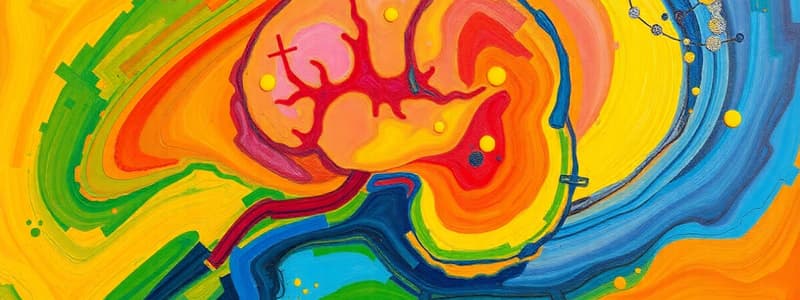Podcast
Questions and Answers
Which process represents a negative feedback loop in the human body?
Which process represents a negative feedback loop in the human body?
- Thermoregulation (correct)
- Childbirth
- Blood clotting
- Muscle contraction during exercise
What is a long-term response to heat exposure that aids in adaptation?
What is a long-term response to heat exposure that aids in adaptation?
- Reduced core temperature
- Increased plasma volume (correct)
- Decreased sweating
- Increased sodium chloride loss in sweat
If water content in cells is not properly regulated, what could occur?
If water content in cells is not properly regulated, what could occur?
- Cells could burst from too much water. (correct)
- Cells would become more efficient at energy production.
- Cells would adapt without harm.
- Cells would increase metabolic activity.
Which system is mainly responsible for regulating oxygen and carbon dioxide levels in the body?
Which system is mainly responsible for regulating oxygen and carbon dioxide levels in the body?
How is blood pressure regulated in the body?
How is blood pressure regulated in the body?
What is the definition of homeostasis?
What is the definition of homeostasis?
Which part of the body serves as the control center for thermoregulation?
Which part of the body serves as the control center for thermoregulation?
What is osmoregulation?
What is osmoregulation?
Which of the following is NOT a mechanism for heat production in the body?
Which of the following is NOT a mechanism for heat production in the body?
How does the body respond to cold exposure?
How does the body respond to cold exposure?
What is the role of negative feedback in homeostasis?
What is the role of negative feedback in homeostasis?
Which hormone is involved in the body’s response to cold by increasing heat production?
Which hormone is involved in the body’s response to cold by increasing heat production?
What happens during negative feedback regulation when CO2 levels rise during exercise?
What happens during negative feedback regulation when CO2 levels rise during exercise?
Flashcards are hidden until you start studying
Study Notes
Homeostasis
- Homeostasis: Maintaining a stable internal environment.
Thermoregulation
- Control center for thermoregulation: Hypothalamus.
Osmoregulation
- Osmoregulation: Regulating water content in the body.
Heat Production Mechanisms
- Sweating is NOT a mechanism for heat production.
- Shivering, increased metabolism, and hormonal release (e.g., thyroxine) increase heat production.
Body's Response to Cold
- Responses to cold exposure include shivering and reduced skin blood flow.
Blood Glucose Regulation
- Key organ in blood glucose regulation: Pancreas.
Negative Feedback in Homeostasis
- Negative feedback counteracts changes and restores the body to its set point.
Heat Acclimatization
- Heat acclimatization increases sweat rate.
Importance of Stable Internal Conditions
- Maintaining stable blood pressure, CO2 levels, and body temperature prevents cell damage and ensures normal physiological functions.
Hormonal Response to Cold
- Thyroxine increases heat production in response to cold.
Body's Response to Overheating
- Responses to overheating include sweating and vasodilation.
Negative Feedback and CO2 Levels During Exercise
- When CO2 levels rise during exercise, breathing rate increases to exhale more CO2 (negative feedback).
Negative Feedback Loop Example
- Thermoregulation is an example of a negative feedback loop.
Long-Term Response to Heat Exposure
- Increased plasma volume is a long-term adaptation to heat exposure.
Consequences of Poor Water Regulation
- Improper water regulation can cause cells to burst from excess water.
Oxygen and Carbon Dioxide Regulation
- Respiratory system primarily regulates oxygen and carbon dioxide levels.
Catecholamines and Thermoregulation
- Catecholamines (like adrenaline) increase heat production by stimulating metabolic processes.
Cold Acclimatization
- Cold acclimatization is the body's ability to adapt to long-term cold exposure.
Blood Pressure Regulation
- Blood pressure is regulated through negative feedback mechanisms involving baroreceptors.
Osmoregulation and Physiological Condition
- Osmoregulation controls water and salt balance.
Studying That Suits You
Use AI to generate personalized quizzes and flashcards to suit your learning preferences.




